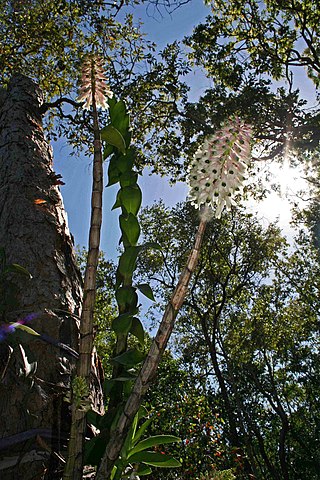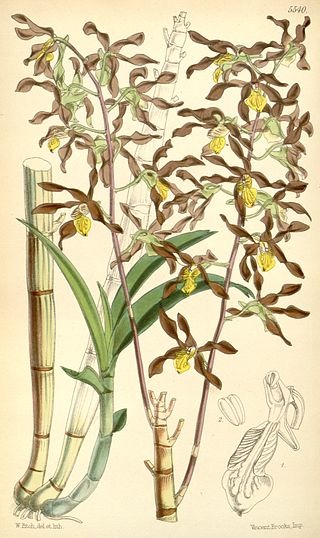
Dendrobium discolor, commonly known as antler orchid or golden orchid, is a species of epiphytic or lithophytic orchid in the family Orchidaceae, and are native to northern Australia, New Guinea, and part of Indonesia. It has cylindrical pseudobulbs, each with between ten and thirty five leathery leaves, and flowering stems with up to forty mostly brownish or greenish flowers with wavy and twisted sepals and petals.

Dendrobium gracilicaule, commonly known as the blotched cane orchid or yellow cane orchid, is an epiphytic or lithophytic orchid in the family Orchidaceae. It has cylindrical pseudobulbs, between three and seven thin leaves and up to thirty often drooping, cream-coloured to yellow or greenish flowers, sometimes with reddish brown blotches on the back. There are two varieties, one occurring in Queensland and New South Wales and the other on some Pacific Islands, including Lord Howe Island.

Dendrobium jonesii, commonly known as the oak orchid is a species of epiphytic or lithophytic orchid endemic to far north Queensland. It has spindle-shaped pseudobulbs, up to seven thin, dark green leaves and up to thirty five crowded, star-like, fragrant cream-coloured or white flowers with purple markings on the labellum.

Dendrobium smillieae, commonly known as the bottlebrush orchid, is an epiphytic or lithophytic orchid with large, spongy pseudobulbs, thin, bright green leaves which are shed after their first year and crowded flowers in a bottlebrush-like arrangement. The flowers are white, to cream-coloured or pink and the labellum has a shiny, dark green tip. This orchid species is found in some of the Torres Strait Islands, and through Cape York Peninsula to Townsville, Queensland. It is also found in New Guinea and eastern Indonesia.

Dendrobium johannis, commonly known as the chocolate tea tree orchid, is a species of epiphytic or lithophytic orchid native to Australia and New Guinea. It has spindle-shaped pseudobulbs, between five and ten dark green leaves with purplish markings and flowering stems with up to fifteen chocolate brown flowers with a yellow labellum.
Dendrobium brachypus, commonly known as the dwarf cane orchid, is an epiphytic or lithophytic orchid in the family Orchidaceae. It has crowded, yellowish green pseudobulbs, dark green leaves and two or three cream-coloured to whitish or greenish flowers which often do not open fully. It grows on trees and rocks on one mountain on Norfolk Island.

Dendrobium adae, commonly known as the slender cane orchid, is an epiphytic, sometimes lithophytic orchid in the family Orchidaceae. It has cylindrical pseudobulbs, up to four dark green leaves and up to six white or greenish to apricot-coloured flowers. It grows in tropical North Queensland, Australia.

Dendrobium baileyi, commonly known as the blotched gemini orchid, is an epiphytic or lithophytic orchid in the family Orchidaceae and has arching stems and flowering stems with one or two spidery, yellow flowers with dark purple spots emerging from leaf axis. It grows in tropical North Queensland, New Guinea and the Solomon Islands.
Dendrobium fellowsii, commonly known as the native damsel orchid, is an epiphytic or lithophytic orchid in the family Orchidaceae and has upright pseudobulbs, up to five leaves and groups of up to five pale green or yellowish flowers with a deep purple labellum. It grows in tropical North Queensland.

Dendrobium bifalce, commonly known as the native bee orchid, is an epiphytic or lithophytic orchid in the family Orchidaceae. It has spindle-shaped pseudobulbs with up to four leathery leaves and up to ten pale green or greenish yellow flowers with purplish markings. It grows on trees and boulders in rainforest in tropical North Queensland, Australia and in New Guinea.

Dendrobium canaliculatum, commonly known as the brown tea tree orchid or thin tea tree orchid, is an epiphytic or lithophytic orchid in the family Orchidaceae. It has cone-shaped or onion-shaped pseudobulbs, up to six deeply channelled, dark green leaves and up to thirty star-shaped, light brown to caramel-coloured white or greenish to apricot-coloured flowers with darker tips. It grows in tropical North Queensland and New Guinea.

Dendrobium carronii, commonly known as the pink tea tree orchid, is a small epiphytic orchid in the family Orchidaceae. It has cone-shaped or onion-shaped pseudobulbs, between two and four channelled, green to purplish leaves and up to twelve star-shaped, pink flowers with dark brown and purple markings. It grows in tropical North Queensland and New Guinea.

Dendrobium fleckeri, commonly known as the apricot cane orchid, is a species of epiphytic or lithophytic orchid endemic to far north Queensland, Australia. It has cylindrical pseudobulbs with two or three dark green leaves and up to four apricot-coloured or yellowish green flowers with tangled white hairs on the edge of the labellum.

Dendrobium nindii, commonly known as the blue antler orchid, is an epiphytic or lithophytic orchid in the family Orchidaceae. It has erect, cylindrical, leafy pseudobulbs with leathery, dark green leaves and up to twenty mauve or violet flowers with darker veins on the labellum. This antler orchid occurs in tropical North Queensland and New Guinea.

Dendrobium taylorii, commonly known as the smooth burr orchid, is an epiphytic or lithophytic orchid in the family Orchidaceae and is endemic to tropical North Queensland, Australia. It has a single leathery, dark green leaf on a cylindrical stem and one or two small white flowers. Unlike other burr orchids, this species is insect-pollinated. It grows in rainforest, mangroves and sheltered forests.
Dendrobium clementsii, commonly known as the Cape York crimp orchid, is a species of epiphytic or lithophytic orchid that is endemic to tropical North Queensland, Australia. It has long stems, tapering pseudobulbs each with a thin, leathery dark green leaf and clusters of short-lived, cream-coloured flowers with a purple labellum.
Dendrobium neospectabile, commonly known as the Eungella king orchid, is a species of epiphytic or lithophytic orchid that is endemic to tropical North Queensland. It has cylindrical, yellowish green pseudobulbs, up to three thick, leathery leaves and up to two hundred and fifty crowded cream-coloured to pale yellow flowers with reddish purple streaks on the labellum.
Dendrobium crassum, commonly known as the tableland feather orchid, is a species of epiphytic orchid that is endemic to tropical North Queensland. It has cylindrical, dark reddish brown pseudobulbs, up to three thick, leathery leaves and up to ten white flowers with purplish markings on the labellum.
Dendrobium deuteroeburneum, commonly known as the rainforest feather orchid, is a species of epiphytic or lithophytic orchid that is endemic to eastern Australia. Its pseudobulbs are cylindrical, pressed against the host tree or rock and have one or two leathery, dark green leaves and up to seven pale greenish cream-coloured flowers with purple markings on the labellum.
Bryobium eriaeoides, commonly known as brittle urchin orchid, is an epiphytic or lithophytic clump-forming orchid that has fleshy, green pseudobulbs, each with two leaves and between three and twelve cup-shaped white to purplish flowers but that sometimes remain closed. This orchid occurs in New Guinea and Queensland.














